Welcome to Shibari 101, your chance to learn the building blocks of Japanese rope bondage! Today, you’ll learn history, basics and safety.
For me, the methodical repetition and precise structure of rope bondage is calming. As a rope top, no matter what else is going on in my life, I have to be present to focus on the ties, the bottom I’m tying up, and the tone of the encounter. I get off on the bottom both giving up control and having fun.
For a bottom, being restrained can also feel very calming. A lot of bottoms feel relaxed and blissed out while in rope. One told me: “I like giving over control to the top, letting them do whatever they want to me and feeling their power as they tie. I also really like the sensation; the pain and restriction feel exquisite.” Another said: “As someone who gets off on giving up power/control, I really enjoy the psychological sensation of being restrained, as well as the challenge of persevering through discomfort. That feeling of someone else/the rope controlling how my body is able to move is freeing to me; I don’t have to make decisions, I don’t have to be in control, but in a safe context. It’s soothing, and makes me feel focused and light and able to be very present.”
Playing with rope bondage is usually an emotionally intimate space to share. It can be rough and sexual, soft and non-sexual, or anywhere in between.
What Is Shibari?
Shibari (also often referred to as kinbaku) is a form of Japanese rope bondage. It differs from Western rope bondage a few ways: it uses non-stretchy natural fiber rope, either jute or hemp, instead of softer cotton, silk or polyester rope; it focuses on friction and wraps instead of knots; it uses the rope doubled over at the middle, a point called the bight, and works down toward the ends; and it has a deep focus on the aesthetic of the ties.
Shibari uses building blocks and repeated patterns that fit together to create ties. Once you learn these blocks and patterns and some basic safety, you can often figure out how to repeat a tie you see elsewhere. (You’ll learn several of these building blocks in the rest of this series.)
Shibari is derived from Hojojutsu, a martial art used in the Edo period (1600 to the mid-1800s) by the Samurai to arrest and restrain prisoners with rope. Often prisoners were publicly shamed by being displayed tied in ropes, which usually conveyed their class and crime, before execution or imprisonment. Hojojutsu died away at the end of the Edo period when the shogunate were overthrown.
People in Japan started to use the Hojojutsu ties for BDSM, and to play with the physical restraint and emotional shame of being tied. This art of tight and often painful sexual or sensual tying became known as shibari (decorative tying) or kinbaku (tight binding).
More recently, shibari has started to become popular in BDSM communities worldwide. While those who are not Japanese won’t be able to fully understand or experience the shame aspect of being tied, the complexity, efficiency and attractiveness of the ties themselves have earned appreciation for this style of rope bondage. Some of the most popular Japanese performers and rope tops even travel worldwide to perform on stage or to teach classes and workshops.
Unfortunately, with the worldwide growth of shibari, there has been some questionable copying or exoticising of the cultural aesthetic of the Japanese performances and photographs — non-Japanese people wearing kimono, or rope tops only tying small Asian women as rope bottoms, for example. Instead, practice the ties, be knowledgeable about and respectful of where they come from, and make the encounter be about you and your experience.
What About The Rope?
Jute and hemp are the most popular materials used in shibari. The rope is often seven to eight meters long, four to six millimeters thick, and usually consists of three smaller strands twisted together. Natural fiber ropes have more grip, a necessary quality here — shibari doesn’t use many knots, and its wrapping techniques require the rope have grip — and so are better than silk or synthetic ropes, which don’t hold friction well and can also lead to faster rope burn. In my opinion, natural fiber ropes also look better and the unyielding tension feels better for the bottom.
Jute and hemp rope must be treated before use by being boiled to soften, dried under tension to keep the correct shape, singed with flame to remove the fuzzies, and oiled so it’s not dry. You can buy raw rope and do this yourself, or you can buy pretreated rope. I recommend buying pretreated rope at first, but it can be fun to buy raw rope and condition it yourself in the future.
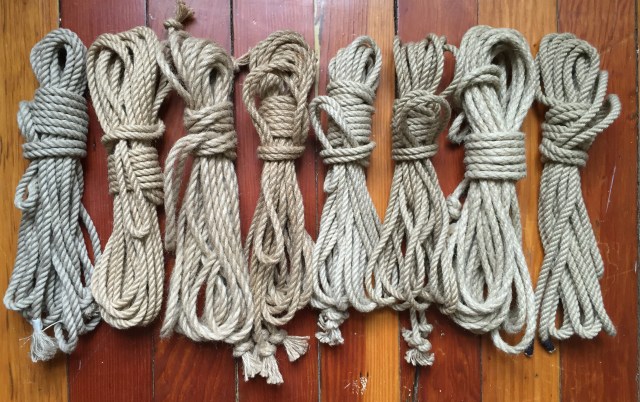
Some shibari rope. All these hanks are 8m long and 6mm thick. From left to right: linen hemp (raw, but does not need to be washed/singed/oiled), jute (raw, very stiff and needs treatment), jute (washed, but not yet singed or oiled), jute (washed, singed and oiled), jute, a tighter lay of rope (washed and singed), jute, same tighter lay (washed, singed and oiled), hemp (raw, very stiff and rough, needs treatment), and synthetic.
Where Do You Buy Rope?
- Esinem Rope (This is my favorite place to buy rope and the only place which carries linen hemp, which I love.)
- Jade Rope
- Twisted Monk
- Erin Houdini
- Kankinawa.com
- My Nawashi (Etsy)
How Do You Care For Natural Fiber Bondage Rope?
Rope often arrives with a single overhand knot at the ends to stop it from fraying. You can leave those knots as they are (and retie them when they come undone), whip the ends with some waxed thread, or make a more complicated knot. I whipped some of mine with a Sailmaker’s Whipping and used waxed sail thread, which has held up well with a lot of use. Store rope wrapped in bundles (hanks) so it doesn’t get tangled and twisted.
Cleaning your rope is not recommended, as you need to wash, dry, singe and oil it every time. Each time you repeat this process it weakens the rope’s fibers, which is very dangerous as it makes play unpredictable, and makes the rope unfit for suspensions. The best way to have clean rope is to not get it dirty. If you want to do crotch ties, I recommend setting aside a specific rope for that person for that purpose, or using synthetic rope that can go in the washing machine.
If your rope gets dry, oil it with jojoba oil. Just rub a few drops in the your palm and run the rope through your hands; don’t overdo it.
How to Tie a Figure Eight Hank
To tie rope in a figure eight hank for storage, first run your hands gently down the length of the rope to straighten it and pull out any knots, kinks or overwound tightness.
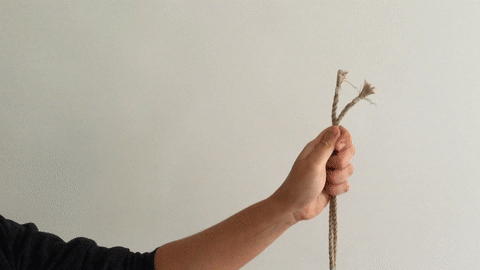
Then grasp the two ends with your right hand. Run your left hand about 10″/25cm down the rope and create a loop with your thumb. Bring your left hand up and create another loop with your right thumb the same distance down the rope. Alternate this motion until you have about 20″/50cm of rope remaining.
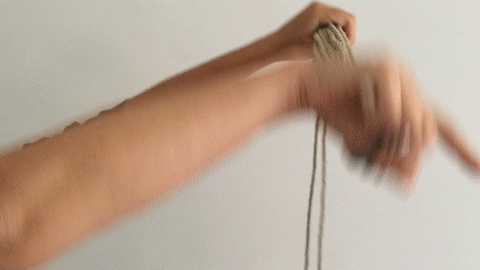
When you have about 20″/50cm remaining, tightly grasp the top of your rope bundle with your left hand.
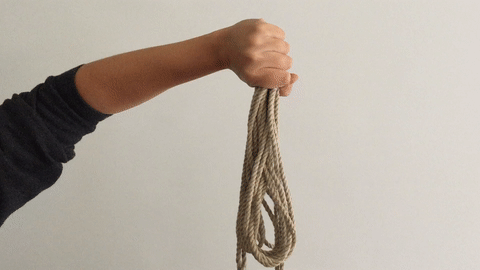
Take the end of your rope and wrap it tightly around the bundle once. Wrap it one more time above the first wrap, to lock it in place so it doesn’t slip. Then continue wrapping a few more times below the top wraps, keeping the rope very tight.
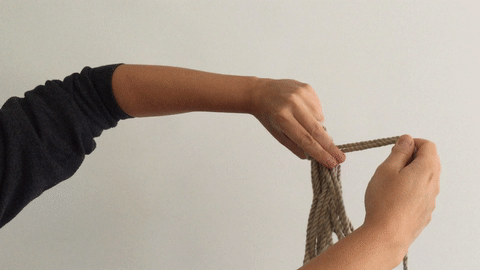
On your final wrap, place your index and middle fingers over the wraps facing downwards. Wrap the final wrap over your fingers, and then bring it around and grasp the rope between those two fingers, and then pull it through. Either bring it all the way through, or stop half way to create a slip knot (shown).
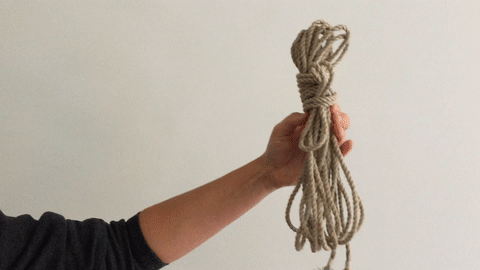
Untying a hank is very fast and your rope stays nice and neat and untangled, and there’s no need to figure out where the bight is, as it’s the part you pull to untie the hank.
Safety for Both Partners
- Communication is important! Know and communicate your limits, experience and ability.
- Make sure you trust and are really comfortable with your rope partner.
- Make sure you are both sober.
- Always check in before the first time you play with someone — don’t assume they know what they’re doing or how to be safe. Make sure you both feel comfortable with each others abilities, and have hashed out what exactly you’re going to do before the rope comes out. Figure out and discuss ahead of time what your plan is, and what your boundaries are.
- Know and communicate your aftercare needs (cuddles, comfort, snacks, space, etc.) before you play.
- Have safety shears on hand just in case.
Safety for Bottoms (Tops, Read This Too!)
- Check in with yourself to make sure you don’t think you will be claustrophobic or panicky in rope, and are in a good mental state.
- Let your top know about any past or current physical injuries or conditions that might affect flexibility or cause pain.
- When you play, pay attention to any tingling, numbness, coldness or burning in your limbs, especially your hands and fingers, and notify your top ASAP. You are not being a good bottom by keeping quiet. You can do serious and potentially permanent nerve damage if you let that go for awhile.
- It’s okay to need out of rope — don’t be ashamed or embarrassed. Tell your top ASAP.
Safety for Tops (Bottoms, Read This Too!)
- Ask whether your bottom has any physical injuries or conditions that might affect the ties.
- Ask whether your bottom has any body parts they don’t want tied up, don’t want touched, have dysphoria with, or don’t want to accentuate. Ask if they have body parts they do want to accentuate.
- Before you tie someone up, look at and feel their hands to see the baseline color and temperature so you can notice later if they change color or get cold. If you notice color or temperature change, loosen a tie or do something else. Leaving a tie that cuts off circulation can lead to or mask nerve damage.
- Check in often with your bottom, especially if you’re new to playing together like this. Simply ask how they’re doing, or work out a way to check in without breaking the mood, such as grasping their hand and having them squeeze if they’re okay.
- Watch your bottom and make sure they’re communicating with you. If your bottom can’t speak (e.g., because they’re gagged), find another way for them to communicate.
- Don’t leave your bottom alone for more than a minute or two, and never be too far you can’t hear them.
- If your bottom experiences tingling or numbness, remain calm and supportive. Ask them to rotate their wrists or open and close their hands or wiggle their toes to get the blood moving, and if the area is still tingly, calmly and quickly untie them. Cutting the rope off is not unreasonable if numbness happens — especially if it happens quickly and in a localized area (like one or two fingers).
- Do tie rope over large muscle groups — upper arms, thighs, chest, hips.
- Do not tie under armpits, or put knots in the back of knee, inner wrists or inner thigh. Beginners should stay away from neck ties. Watch where you put knots because of the possibility of nerve damage.
- It’s your responsibility to learn some basic anatomy — where muscle groups are, where nerve bundles are, etc. — in order to tie safely.
- Hands are often the first thing to go numb/lose circulation so you may want to consider tying the wrists last.
- If your bottom needs out of rope ASAP, remove the ties as quickly and calmly as possible. Speak to them evenly and reassure them that they are safe. It may be helpful to give them something to do, such as counting backwards from 100 and focusing on deep belly breaths (not short chest breaths). If you can’t untie them fast enough, cut them out! Rope is replaceable. Once they are untied and calm, reassure them that it’s completely okay to want out before a scene is naturally over, and you’re not upset with them! It builds trust to communicate limits, and if your bottom wants to try playing with rope again, your support will make them more comfortable for next time.
Next week, you’ll learn the two ties that are the foundation of many others!



I love shibari and I’m excited it’s come to AS! And this is such an informative article for beginners ? (esp love the gifs….I sent it to the gf because she got frustrated when I tried to teach her the other day how to tie up the hanks….although I actually double the bight through the “top” loop instead of under the wraps)
Can def recommend rope from MyNawashi
i’m glad the gifs are helpful — it seemed to be the best format to watch each step. :) I’m glad you’re excited for the series!
Solid advice. I’m so glad this is going to be a serie!
Nicely written guide, very clear, great pics.
I would also like to put in a plug for non-shibari rope bondage. It’s great to learn the techniques, but as I’m sure this writer knows, shibari is far from being the only way to have awesome times with rope bondage. Google for Midori’s dildo harness as a classic example of a “hybrid” kind of very fun tie.
I’ve got great friends who are real shibari geeks, but I actually didn’t practice ropy play myself for a very long time after trying to get into it, because once you get into the more advanced areas, it’s a lot like martial arts … both good and bad aspects of it. You can meet some amazing gurus, and some less-amazing ones (and I find the term “models”, as commonly used in shibari to refer to rope bottoms, gets right up my nose). To be honest, my style doesn’t lend itself to the Japanese aesthetic, and it took some time to trust myself again and that it doesn’t mean that my style is not effective (and that I don’t take good care of my partners).
Anyway, blah blah, my story is really just to shout out to anyone who does rope or who is curious about it, but may not relate to this particular style – there are many other styles, and of course it doesn’t matter how much of a shibari geek you are, you always develop your own personal style anyway.
And it’s great to see something that looks like it’s going to be informative, well-presented and meticulous about a core BDSM activity here on AS. Learning the basic shibari techniques is a great place to start.
Really interesting read, thank you
Really looking forward to this series, the gifs are amazing and the completeness of the material provided inspires confidence.
Do you have an article planned for accommodating disabilities? Or would you be willing to recommend a community that might have resources to address disabled bodies, please?
I’ve been with this incredible soul since 15yo. We’re now in our latter 50s. Have become more and more moved/excited in fantasy about integrating this into our intimate relationship. Willing to hire a knowledgeable tutor for our exclusive education. Just looking to further expand our intimacy for each other, only. Your advice would be greatly appreciated. Tia,Mike
This has really given me the confidence to move in the direction that I’ve always wanted to explore. Thank you very much
Very Nice Website, I really Appreciate your contents, this is very meaning for us.
https://kingpure.in/
Japanese Rope Bondage is something I always try but never succeed, I tried to learn from many resources but none of them was as clear as this article.
Now whenever I am free, either I am browsing https://www.4images1motsolution.info/ for answers of my fav 4 Images 1 Mot, or I am trying Rope bondage. :p
Very much appreciated the safety aspects here (both physical and emotional) and overall feel this was a great introductory read. Appreciated the history on it as well. Pics were helpful too! But I especially loved the break down of “Safety for Tops (bottoms read too!)” and “Safety for Bottoms (tops read too!)” This was well thought out and well said. Admittedly, I went to another site before this one on their take of Shibari 101 and it was not nearly as informative, sensitive, nor did it go into safety detail (ex. “ropes are replaceable!” Cut them if need be).
Thnak you for sharing information, Approach the content with an open mind and a willingness to learn. Shibari is an art form with a long history, and there is much to be gained from studying it.